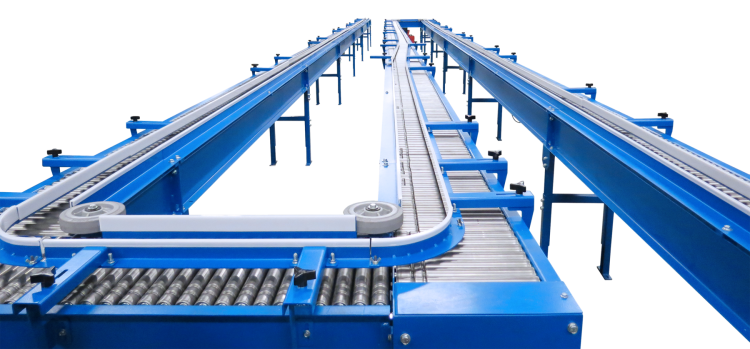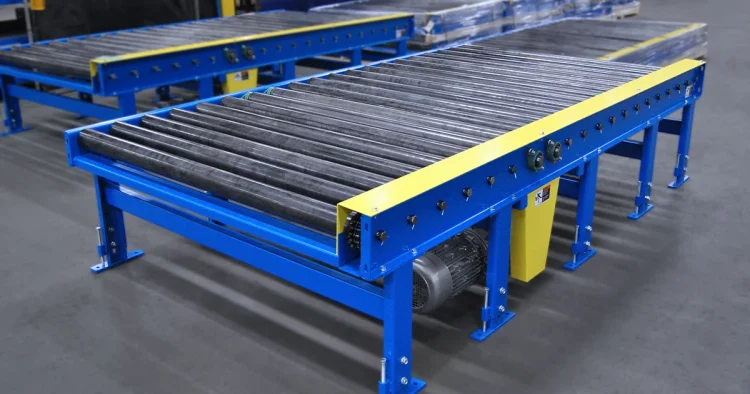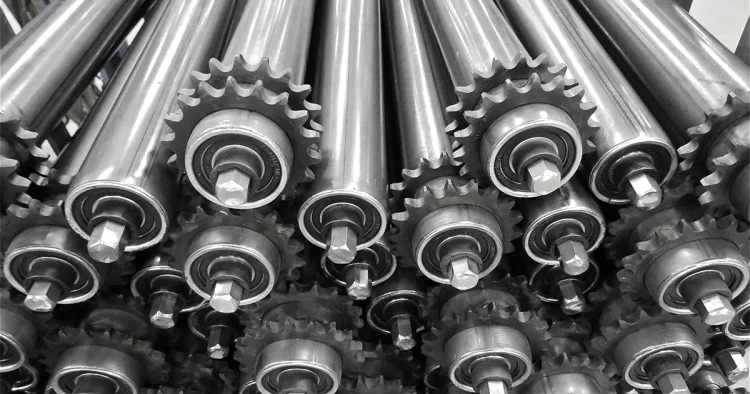
That grinding noise from your conveyor line isn’t just annoying, it’s eating into your production time and signalling an expensive problem if ignored. Worn rollers don’t just slow down your line; they damage products, increase energy costs, and eventually lead to complete system failure.
The good news? Replacing conveyor rollers doesn’t have to be complicated or costly when you know what you’re doing. After helping thousands of Ontario manufacturers keep their lines running smoothly, we’ve learned that most roller replacement headaches come from ordering the wrong parts due to improper measurements or specification confusion.
Let’s cut through the complexity and walk through exactly how to measure and order the right replacement rollers for your conveyor system—saving you time, preventing costly mistakes, and keeping your production line moving.
Why Replacement Conveyor Rollers Need Precise Measurements
When a conveyor roller fails, the temptation is to quickly grab a tape measure, take a rough length measurement, and place an order. This approach often leads to costly mistakes.
Manufacturing tolerances for conveyor rollers are precise for good reason. A roller that’s even slightly too long or short can create tracking problems, excessive wear, and premature failure of other components.
The wrong bearing specification can lead to early breakdown under load, while incorrect material choices might create excessive friction or fail to support your products properly.
According to an ABB survey on industrial downtime, unplanned outages cost Canadian businesses significantly more than the global average, with most experiencing these disruptions at least once a month. Getting your roller specifications right the first time eliminates these unnecessary delays and the substantial costs that come with them.
Essential Measurements for Conveyor Rollers
Here’s what you’ll need to accurately measure and specify your replacement rollers:
1. Between Frame Rail (BFR) Dimension
The Between Frame Rail measurement is the critical starting point for roller replacement. This measures the clear width between the inside edges of your conveyor frame.
How to measure BFR correctly:
- Measure directly between the inside edges of your conveyor’s side frames.
- Take measurements at multiple points along the conveyor to account for any frame variation.
- Record the sixteenths of an inch for precision.
The BFR dimension helps determine your roller’s face length (the usable portion that supports your product).
2. Axle Length
The Axle Length is the total length of the roller from end to end, including any shaft extensions.
How to measure Axle Length correctly:
- Measure from the outermost point of one end to the outermost point of the opposite end.
- Ensure you include shaft extensions in your measurement.
- For rollers with different end types, measure the complete roller assembly.
3. Tube Diameter
The tube diameter affects load capacity, durability, and compatibility with your existing system.
How to measure tube diameter correctly:
- Use callipers for the most accurate measurement.
- Measure across the widest part of the roller tube.
- Clean the roller surface before measuring to avoid inaccurate readings from buildup.
Common tube diameters for industrial applications include:
- Light Duty: 1-3/8″ to 1-1/2″
- Medium Duty: 9″ to 2-1/2″
- Heavy Duty: 2-1/2″ to 3-1/2″
4. Shaft Diameter
The shaft diameter must match your conveyor frame’s bearing housing or mounting brackets.
How to measure shaft diameter correctly:
- Use callipers to measure the diameter of the shaft (not the tube).
- Measure at the point where the shaft meets the bearing.
- Clean any grease or debris before measuring.
Common shaft diameters include 5/16″ Hex, 7/16″ Hex, 11/16″ Hex, and 1-1/16″ Hex, depending on load requirements.
5. End Type Configuration
End types vary based on conveyor design and application needs.
Retention Methods:
- Standard: Spring loaded one side
- Optional: Cotter Pin, Fixed Pin, Loose Bolt or Fixed Axle
End Types:
- Straight
- Grooved
- Sprocket
- V Belt
Record both the type and dimensions of each end.
Capacity Considerations: Getting the Right Roller for Your Load

Beyond measurements, you need to consider the weight your rollers must support.
Rolmaster’s conveyor rollers come in various capacity ratings:
- Light Duty: Up to 82.5 kg (182 lbs) per roller.
- Medium Duty: 110-349 kg (243-770 lbs) per roller, depending on the model.
- Heavy Duty: Up to 453.6 kg (1000 lbs) per roller with reinforced designs.
For proper selection, calculate:
- The maximum weight of your heaviest product.
- How many rollers will support that product at any time.
- Apply an appropriate safety factor based on your application requirements.
Consider capacity ratings carefully when selecting rollers to ensure your conveyor can handle your application’s requirements, including any unexpected loads or operational stresses.
Special Considerations for Different Conveyor Types

Different conveyor systems require specific roller considerations:
For Chain-Driven Live Roller (CDLR) Systems:
- Ensure sprocket size, tooth count, and bore match your existing system.
- Verify chain pitch (typically 40, 50, 60, or 80).
- Consider double-sprocketed rollers for heavy loads.
- Check for proper alignment between sprockets and chain.
An example of a heavy steel pallet transfer project used custom CDLR rollers with reinforced shafts to handle 2,268 kg (5,000 lb) pallets, demonstrating how critical proper roller specification becomes for heavy-duty applications.
For Drive Systems:
- Determine if the system is v belt, groove or sprocket driven.
- One drive roller powers several slave rollers which are joined through v belts, drive bands in grooves, or chains over sprockets.
Common Ordering Mistakes to Avoid
After helping thousands of Ontario manufacturers with replacement parts, we’ve seen these common mistakes:
- Overlooking retention styles: Spring-loaded mechanisms, cotter pins, fixed pins and other retention methods must match exactly.
- Confusing Between Frame Rail (BFR) with Tube Length: These are different measurements serving different purposes.
- Forgetting to specify material: Standard galvanized steel isn’t appropriate for all applications.
- Not considering environmental factors: High-temperature areas, moisture exposure, or chemical presence may require special materials.
- Ordering based on “looks similar”: Visual similarity doesn’t guarantee proper fit or function.
According to the Canadian Centre for Occupational Health and Safety, proper equipment maintenance including correct part replacement is essential for workplace safety compliance with provincial OHSA regulations.
Creating a Complete Roller Specification Sheet
For accurate replacement ordering, create a specification sheet with these details:
For accurate replacement ordering, create a specification sheet with these details:
- Between Frame Rail (BFR) dimension
- Tube Length
- Tube diameter and wall thickness
- Tube material and finish
- Shaft diameter on both ends
- Shaft end types and retention methods
- Load capacity requirements
- Operating environment details
- Conveyor speed (if known)
- Application description
Pro tip: Take clear photos of your existing rollers from multiple angles. Include close-ups of bearing housings, shaft ends, and any unique features. Photos can clarify written specifications and help identify special requirements.
When to Consider Upgrading Rather Than Direct Replacement
Sometimes, direct replacement isn’t your best option. Consider upgrading your rollers when:
- You’re experiencing frequent failures: This might indicate your current rollers are underrated for your application.
- Your production requirements have changed: Increased speeds or heavier products may require upgraded rollers.
- You’re dealing with tracking issues: Crowned or specially designed rollers might solve persistent problems.
- Operating conditions have changed: Environmental factors might necessitate different materials or bearing types.
In applications requiring precise handling at high speeds, roller specifications become even more critical. For instance, our automotive pallet handling case study involved custom MDR conveyors that reliably handled 295 kg (650 lb) pallets at 140 FPM with precision indexing—demonstrating how proper roller selection directly impacts system performance.
The Advantages of Working with a Canadian Roller Manufacturer
Sourcing your replacement rollers from a Canadian manufacturer offers several advantages:
- CEMA, CSA, and OHSA compliance: Rollers built to meet Canadian safety standards from the start.
- Understanding of Canadian operating conditions: Designs account for typical Canadian industrial environments.
- Direct technical support: Face-to-face consultation when measurements are challenging.
- Customization capabilities: Modifications for your specific application needs.
- Faster delivery: No customs delays or international shipping complications.
As highlighted in Global Trade Magazine, strengthening domestic supply chains and fostering local manufacturing partnerships creates greater economic benefits and reduces vulnerability to international disruptions.
Final Checklist Before Ordering
Before submitting your roller replacement order:
- Double-check all measurements
- Confirm shaft end details
- Review capacity requirements
- Consider environmental factors
- Document roller function in your system
- Take reference photos
Taking the time to gather complete specifications saves time and money by avoiding the frustration of incorrect parts and additional downtime.
Moving Forward with Confidence
Properly measuring and ordering replacement conveyor rollers isn’t just about keeping your line running, it’s about optimizing your operation for better performance and reliability.
The right rollers reduce energy consumption, minimize product damage, and extend the life of your entire conveyor system. For complex conveyor systems or custom applications, consider consulting with a conveyor specialist who can help identify the optimal replacement parts for your specific needs.
With 75+ years of experience manufacturing conveyor systems in our Cambridge facility, we’ve seen virtually every roller configuration and application challenge.
Ready to order replacement rollers with confidence? Contact our team for assistance with specifications or to discuss your specific conveyor roller requirements.

